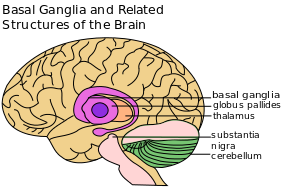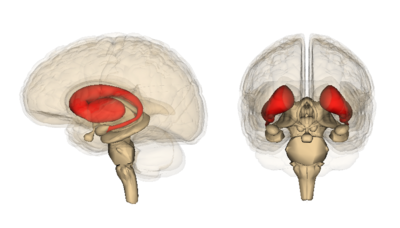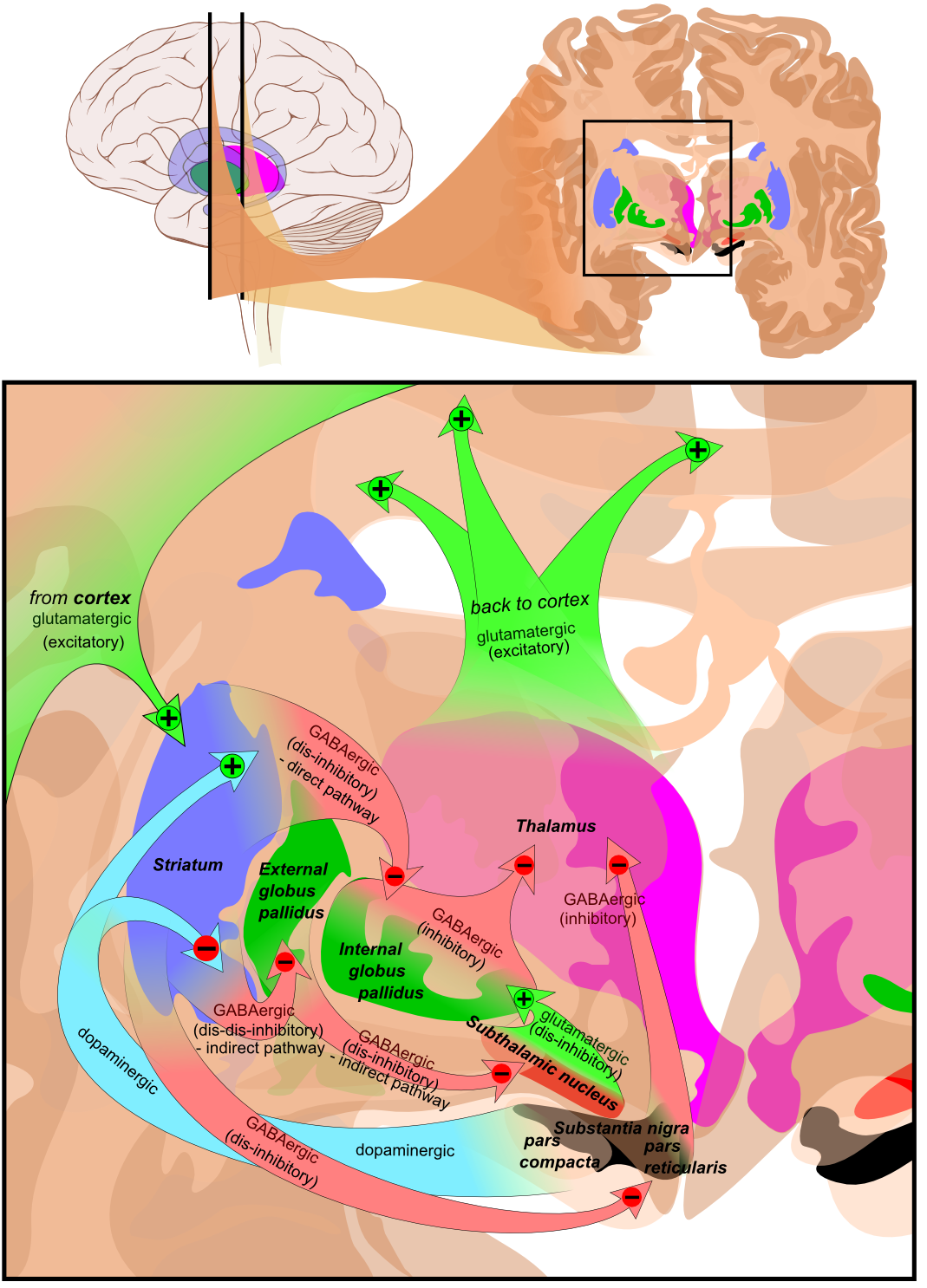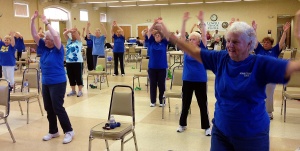Basal Ganglia: Difference between revisions
No edit summary |
No edit summary |
||
| Line 5: | Line 5: | ||
== Introduction to the Basal Ganglia == | == Introduction to the Basal Ganglia == | ||
[[File:Overview of the basal ganglia - Kenhub.png|alt=Overview of the basal ganglia (corpus striatum) - lateral view|300x300px|Overview of the basal ganglia (corpus striatum) - lateral view|thumb]] | |||
The '''basal ganglia''' is a group of subcortical nuclei, located at the base of the forebrain,<ref>Yanagisawa N. [https://www.ncbi.nlm.nih.gov/pmc/articles/PMC6117491/ Functions and dysfunctions of the basal ganglia in humans.] Proc Jpn Acad Ser B Phys Biol Sci. 2018;94(7):275-304. </ref> that is primarily involved in motor control, as well as motor learning, executive functions and emotional behaviours. It also plays an important role in reward and reinforcement, addictive behaviours and habit formation. | The '''basal ganglia''' is a group of subcortical nuclei, located at the base of the forebrain,<ref>Yanagisawa N. [https://www.ncbi.nlm.nih.gov/pmc/articles/PMC6117491/ Functions and dysfunctions of the basal ganglia in humans.] Proc Jpn Acad Ser B Phys Biol Sci. 2018;94(7):275-304. </ref> that is primarily involved in motor control, as well as motor learning, executive functions and emotional behaviours. It also plays an important role in reward and reinforcement, addictive behaviours and habit formation.<ref name=":0">Lanciego JL, Luquin N, Obeso JA. [https://www.ncbi.nlm.nih.gov/pmc/articles/PMC3543080/ Functional neuroanatomy of the basal ganglia.] Cold Spring Harbor perspectives in medicine. 2012 Dec 1;2(12):a009621.</ref> | ||
Basal ganglia network dysfunction leads to various movement disorders,<ref name=":0" /> such as [[Parkinson's]] and [[Huntington Disease|Huntington's Disease.]] | Basal ganglia network dysfunction leads to various movement disorders,<ref name=":0" /> such as [[Parkinson's]] and [[Huntington Disease|Huntington's Disease.]] | ||
== Structure == | == Structure of the Basal Ganglia == | ||
[[File:PD Basal Ganglia etc.png|alt=A line diagram of the main structures of the basal ganglia|left|frameless|Basal ganglia.]][[File:PD Basal ganglia .jpg|middle|frameless]] | [[File:PD Basal Ganglia etc.png|alt=A line diagram of the main structures of the basal ganglia|left|frameless|Basal ganglia.]][[File:PD Basal ganglia .jpg|middle|frameless]] | ||
The '''corpus striatum''' is the largest component of the basal ganglia'''.''' It contains the '''caudate nucleus''' and '''lenticular nuclei''', which is made up of the '''putamen''', '''globus pallidus externus''', and '''globus pallidus internus.''' The '''subthalamic nucleus''' (STN), and the '''substantia nigra''' (SN) are also components of the basal ganglia. These structures work together to promote or inhibit movement.<ref name=":1">Young CB, Sonne J. [https://www.ncbi.nlm.nih.gov/books/NBK537141/ Neuroanatomy, basal ganglia.] InStatPearls [Internet] 2018 Dec 28. StatPearls Publishing.</ref>[[File:Striatum.png|400x400px|thumb|Doral Corpus Striatum ]] | The '''corpus striatum''' is the largest component of the basal ganglia'''.''' It contains the '''caudate nucleus''' and '''lenticular nuclei''', which is made up of the '''putamen''', '''globus pallidus externus''', and '''globus pallidus internus.''' The '''subthalamic nucleus''' (STN), and the '''substantia nigra''' (SN) are also components of the basal ganglia. These structures work together to promote or inhibit movement.<ref name=":1">Young CB, Sonne J. [https://www.ncbi.nlm.nih.gov/books/NBK537141/ Neuroanatomy, basal ganglia.] InStatPearls [Internet] 2018 Dec 28. StatPearls Publishing.</ref>[[File:Striatum.png|400x400px|thumb|Doral Corpus Striatum ]] | ||
* '''Corpus Striatum''': a heterogeneous structure with a volume of around 10 cm<sup>3</sup>. It receives afferent inputs from various cortical and subcortical structures and sends outputs to different basal ganglia nuclei.<ref name=":0" /> There are two main divisions in the corpus striatum: | * '''Corpus Striatum''': a heterogeneous structure with a volume of around 10 cm<sup>3</sup>. It receives afferent inputs from various cortical and subcortical structures and sends outputs to different basal ganglia nuclei.<ref name=":0" /> There are two main divisions in the corpus striatum: | ||
| Line 29: | Line 25: | ||
== Basal Ganglia | == Function of the Basal Ganglia == | ||
The classical basal ganglia model suggested that "information flows through the basal ganglia back to the cortex through two pathways with opposing effects for the proper execution of movement."<ref name=":02">Lanciego JL, Luquin N, Obeso JA. [https://www.ncbi.nlm.nih.gov/pmc/articles/PMC3543080/ Functional neuroanatomy of the basal ganglia.] Cold Spring Harbor perspectives in medicine. 2012 Dec 1;2(12):a009621.</ref> In this "loop", cortical input is sent to the basal ganglia, where it is modified and then sent back to the cortex. As a result of this feedback, motor activity is either facilitated or inhibited.<ref name=":02" /> | |||
This model has been reviewed and updated. It is now believed that the basal ganglia has "multiple parallel loops and re-entering circuits whereby motor, associative, and limbic territories are engaged mainly in the control of movement, behaviour, and emotions."<ref name=":02" /> | |||
The following image illustrates various excitatory and inhibitory pathways from the basal ganglia to the cortex.<ref name=":0" /> | |||
[[File:Basal ganglia circuits.png|center|alt=This is a diagram of the flow of excitatory and inhibitory pathways through the basal ganglia.|frame|Basal ganglia circuits]] | [[File:Basal ganglia circuits.png|center|alt=This is a diagram of the flow of excitatory and inhibitory pathways through the basal ganglia.|frame|Basal ganglia circuits]] | ||
== Pathophysiology == | == Pathophysiology == | ||
Dysfunction of the basal ganglia is associated with specific movement disorders, and can cause issues such as (1) tremor, (2) involuntary muscle movements, (3) abnormal increase in tone, (4) difficulty initiating movements, and (5) abnormal posture. The following sections discuss movement disorders associated with basal ganglia dysfunction.<ref name=":1" /> | |||
=== Parkinson's === | === Parkinson's === | ||
Parkinson's is the second most common neurodegenerative disorder. Its aetiology is multifactorial, with both genetic and environmental risk factors identified.<ref>Ben-Shlomo Y, Darweesh S, Llibre-Guerra J, Marras C, San Luciano M, Tanner C. The epidemiology of Parkinson's disease. The Lancet. 2024;403(10423):283-92.</ref> Parkinson's is characterised "by the progressive loss of dopaminergic neurons and the formation of Lewy bodies in the affected brain areas".<ref name=":3">Zhou, ZD, Yi LX, Wang DQ, Lim TM, Tan EK. [https://translationalneurodegeneration.biomedcentral.com/articles/10.1186/s40035-023-00378-6 Role of dopamine in the pathophysiology of Parkinson’s disease]. Transl Neurodegener. 2023;12(44). </ref> Because of the degeneration of dopaminergic neurons, there is less dopamine available in the substantia nigra and striatum, which causes various clinical signs of Parkoons's such as:<ref name=":3" /> | |||
* tremor | |||
* postural instability | |||
* [[bradykinesia]] | |||
* muscle rigidity | |||
If you would like to learn more about this condition, please see: [[Parkinson's]]. | |||
=== Huntington's Disease === | === Huntington's Disease === | ||
Revision as of 12:01, 19 June 2024
Introduction to the Basal Ganglia[edit | edit source]
The basal ganglia is a group of subcortical nuclei, located at the base of the forebrain,[1] that is primarily involved in motor control, as well as motor learning, executive functions and emotional behaviours. It also plays an important role in reward and reinforcement, addictive behaviours and habit formation.[2]
Basal ganglia network dysfunction leads to various movement disorders,[2] such as Parkinson's and Huntington's Disease.
Structure of the Basal Ganglia[edit | edit source]
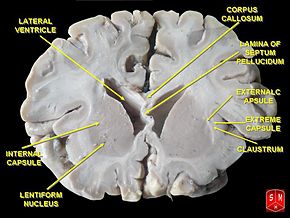 The corpus striatum is the largest component of the basal ganglia. It contains the caudate nucleus and lenticular nuclei, which is made up of the putamen, globus pallidus externus, and globus pallidus internus. The subthalamic nucleus (STN), and the substantia nigra (SN) are also components of the basal ganglia. These structures work together to promote or inhibit movement.[3]
The corpus striatum is the largest component of the basal ganglia. It contains the caudate nucleus and lenticular nuclei, which is made up of the putamen, globus pallidus externus, and globus pallidus internus. The subthalamic nucleus (STN), and the substantia nigra (SN) are also components of the basal ganglia. These structures work together to promote or inhibit movement.[3]
- Corpus Striatum: a heterogeneous structure with a volume of around 10 cm3. It receives afferent inputs from various cortical and subcortical structures and sends outputs to different basal ganglia nuclei.[2] There are two main divisions in the corpus striatum:
- Dorsal Striatum (DS) (shown in red in image): mostly involved in the control of conscious motor movements and executive functions. The dorsal striatum consists of the caudate nucleus and the putamen. The internal capsule is a white matter nerve tract in the dorsal striatum separates the caudate nucleus from the putamen.
- Ventral Striatum: involved in the limbic functions of reward and aversion. It is made up of the nucleus accumbens and the olfactory tubercle.[3]
- Internal and external segments of the Globus Pallidus: together, the globus pallidus and putamen form the lentiform (or lenticular) nucleus.[4]
- Subthalamic Nucleus (STN): a lens-shaped cell group that makes up a large part of the subthalamus.[5]
- Substantia Nigra (SN) - (which means "black substance" in Latin): while the substantia nigra is located in the midbrain, it is considered part of the basal ganglia. This long nucleus has two parts: 1) pars compacta and 2) pars reticulata. Degeneration of the pars compacta decreases the amount of available dopamine.[6]
The two optional videos below provide further information on the structure and function of the basal ganglia:
Function of the Basal Ganglia[edit | edit source]
The classical basal ganglia model suggested that "information flows through the basal ganglia back to the cortex through two pathways with opposing effects for the proper execution of movement."[9] In this "loop", cortical input is sent to the basal ganglia, where it is modified and then sent back to the cortex. As a result of this feedback, motor activity is either facilitated or inhibited.[9]
This model has been reviewed and updated. It is now believed that the basal ganglia has "multiple parallel loops and re-entering circuits whereby motor, associative, and limbic territories are engaged mainly in the control of movement, behaviour, and emotions."[9]
The following image illustrates various excitatory and inhibitory pathways from the basal ganglia to the cortex.[2]
Pathophysiology[edit | edit source]
Dysfunction of the basal ganglia is associated with specific movement disorders, and can cause issues such as (1) tremor, (2) involuntary muscle movements, (3) abnormal increase in tone, (4) difficulty initiating movements, and (5) abnormal posture. The following sections discuss movement disorders associated with basal ganglia dysfunction.[3]
Parkinson's[edit | edit source]
Parkinson's is the second most common neurodegenerative disorder. Its aetiology is multifactorial, with both genetic and environmental risk factors identified.[10] Parkinson's is characterised "by the progressive loss of dopaminergic neurons and the formation of Lewy bodies in the affected brain areas".[11] Because of the degeneration of dopaminergic neurons, there is less dopamine available in the substantia nigra and striatum, which causes various clinical signs of Parkoons's such as:[11]
- tremor
- postural instability
- bradykinesia
- muscle rigidity
If you would like to learn more about this condition, please see: Parkinson's.
Huntington's Disease[edit | edit source]
Huntington's disease[12] is a hyperkinetic movement disorder. Its cause is a genetic defect manifesting as a CAG repeat on chromosome 4p on the HTT gene. This creates an abnormally long Huntington gene which leads to neuronal death in the caudate and the putamen. The indirect pathway is interrupted and leads to a hyperkinetic presentation.
Symptoms include
Hemiballism[edit | edit source]
Hemiballism[13] (from the Greek “to throw”) is used to describe hyperkinetic, involuntary, forceful movements of the ipsilateral arm and leg. Commonly a lesion in the contralateral subthalamic nuclei causes hemiballism. Given that the subthalamus is part of the indirect pathway this lesion reduces or eliminates indirect pathway signaling, leading to a relative overabundance of activity in the direct pathway. Such causes include stroke, traumatic brain injury, amyotrophic lateral sclerosis, nonketotic hyperglycemia, neoplasm, vascular malformation, and other causes.[13]
Tourette Syndrome[edit | edit source]
Tourette syndrome has been shown to have a significant neurological basal ganglia component which manifests as sudden, repetitive uncontrolled movements and vocalizations, called “tics.” These tics have been associated with dysfunction of the GABAergic projections from the striatum, leading to a relative increase in dopaminergic activity much like in hemiballism and Huntington’s disease[14].
Additionally, parts of the basal ganglia play a key role in reward and reinforcement, addictive behaviours and habit formation. Pathophysiological processes underlying psychiatric disorders such as depression and obsessive-compulsive disorder (OCD) involve the basal ganglia and their connections with many other structures (particularly to the prefrontal cortex and the limbic system).[15] In terms of cognitive disorders, basal ganglia abnormalities have been found in individuals with schizophrenia[16] and may explain the presence of learning deficits associated with the disorder.
Silent Cerebral Infarcts - of interest a 2008 study found that approx. 5% of healthy middle-aged adults have microlesions in their basal ganglia. [17]
Physiotherapy Interventions[edit | edit source]
The importance and value of exercise is becoming more and more apparent for a whole raft of health conditions. Recent evidence regarding exercise and basal ganglia impairments states:
- A 2016 study by Becker et al[18] into cognitive performance and basal ganglia changes concluded that physical activity, especially motor fitness level training, to be a promising tool causing structural changes in the basal ganglia and potential to diminish the cognitive decline in older adults and to support academic success in children and young adults.
- Exercise is beneficial and should be routinely prescribed in the management of Parkinson's (may aid in basal ganglia function)[19].
- Exercise effects on basal ganglia damage:[19]
- The adult brain possesses a tremendous capacity for experience-dependent neuroplasticity, even in the context of ageing and neurodegenerative disorders including Parkinson's, where the activation of neurotrophic factors may play a key role.
- Animal models of dopamine depletion are beginning to reveal the underlying mechanisms by which exercise can remodel the brain through alteration in neuronal synaptic connections, especially dopaminergic and glutamatergic neurotransmission within the basal ganglia.
- Epidemiological studies, clinical observations, and animal research indicate that appropriately dosed physical activity and exercise may not only reduce the risk of developing Parkinson's in vulnerable populations but also benefit these patients by potentially protecting the residual nigrostriatal dopamine neurons or directly restoring the dysfunctional cortico-basal ganglia motor control circuit, and these benefits may be mediated by exercise-triggered production of endogenous neuroprotective molecules such as neurotrophic factors[20].
- Exercise has been implicated in modulating dopamine and glutamate neurotransmission, altering synaptogenesis, and increasing cerebral blood flow. In addition, recent evidence supports that the type of exercise may have regional effects on brain circuitry, with skilled exercise differentially affecting frontal-striatal related circuits to a greater degree than pure aerobic exercise (with skilled exercise differentially affecting frontal related circuits more so than pure aerobic exercise). Thus proving that a combination of these exercises is very advantageous in prolonging the progression of Parkinson's[21].
References[edit | edit source]
- ↑ Yanagisawa N. Functions and dysfunctions of the basal ganglia in humans. Proc Jpn Acad Ser B Phys Biol Sci. 2018;94(7):275-304.
- ↑ 2.0 2.1 2.2 2.3 Lanciego JL, Luquin N, Obeso JA. Functional neuroanatomy of the basal ganglia. Cold Spring Harbor perspectives in medicine. 2012 Dec 1;2(12):a009621.
- ↑ 3.0 3.1 3.2 Young CB, Sonne J. Neuroanatomy, basal ganglia. InStatPearls [Internet] 2018 Dec 28. StatPearls Publishing.
- ↑ Javed N, Cascella M. Neuroanatomy, Globus Pallidus. [Updated 2023 Feb 20]. In: StatPearls [Internet].
- ↑ Basinger H, Joseph J. Neuroanatomy, Subthalamic Nucleus. [Updated 2022 Oct 31]. In: StatPearls [Internet]. Treasure Island (FL): StatPearls Publishing; 2024 Jan-. Available from: https://www.ncbi.nlm.nih.gov/books/NBK559002/
- ↑ Jacobs LK, Sapers BL. Neurological Disease. InPerioperative Medicine 2011 (pp. 343-359). Springer, London.
- ↑ Neuroscientifically Challenged Basal ganglia . Available from: https://www.youtube.com/watch?v=OD2KPSGZ1No [last accessed 14/01/2020]
- ↑ Armando Hasudungan. The Basal Ganglia Clinical Anatomy. Available from: https://www.youtube.com/watch?v=mNc-6q6YAAw [last accessed 05/01/2024]
- ↑ 9.0 9.1 9.2 Lanciego JL, Luquin N, Obeso JA. Functional neuroanatomy of the basal ganglia. Cold Spring Harbor perspectives in medicine. 2012 Dec 1;2(12):a009621.
- ↑ Ben-Shlomo Y, Darweesh S, Llibre-Guerra J, Marras C, San Luciano M, Tanner C. The epidemiology of Parkinson's disease. The Lancet. 2024;403(10423):283-92.
- ↑ 11.0 11.1 Zhou, ZD, Yi LX, Wang DQ, Lim TM, Tan EK. Role of dopamine in the pathophysiology of Parkinson’s disease. Transl Neurodegener. 2023;12(44).
- ↑ 12.0 12.1 Matz OC, Spocter M. The Effect of Huntington's Disease on the Basal Nuclei: A Review. Cureus. 2022;14(4):e24473.
- ↑ 13.0 13.1 Rocha Cabrero F, De Jesus O. Hemiballismus. [Updated 2023 Aug 23]. In: StatPearls [Internet].
- ↑ Caligiore D, Mannella F, Arbib MA, Baldassarre G. Dysfunctions of the basal ganglia-cerebellar-thalamo-cortical system produce motor tics in Tourette syndrome. PLoS Comput Biol. 2017;13(3):e1005395.
- ↑ Stathis P, Panourias IG, Themistocleous MS, Sakas DE. Connections of the basal ganglia with the limbic system: implications for neuromodulation therapies of anxiety and affective disorders. InOperative Neuromodulation 2007 (pp. 575-586). Springer, Vienna.
- ↑ Kéri S. Interactive memory systems and category learning in schizophrenia. Neuroscience & Biobehavioral Reviews. 2008 Jan 1;32(2):206-18.
- ↑ Das RR, Seshadri S, Beiser AS, Kelly-Hayes M, Au R, Himali JJ, Kase CS, Benjamin EJ, Polak JF, O'Donnell CJ, Yoshita M. Prevalence and correlates of silent cerebral infarcts in the Framingham offspring study. Stroke. 2008 Nov 1;39(11):2929-35.
- ↑ Niemann C, Godde B, Staudinger UM, Voelcker-Rehage C. Exercise-induced changes in basal ganglia volume and cognition in older adults. Neuroscience. 2014;281:147-163.
- ↑ 19.0 19.1 Petzinger GM, Fisher BE, Akopian G, Holschneider DP, Wood R, Walsh JP, Lund B, Meshul C, Vuckovic M, Jakowec MW. The role of exercise in facilitating basal ganglia function in Parkinson’s disease. Neurodegenerative disease management. 2011 Apr;1(2):157-70.
- ↑ Hou L, Chen W, Liu X, Qiao D, Zhou FM. Exercise-induced neuroprotection of the nigrostriatal dopamine system in Parkinson's disease. Frontiers in aging neuroscience. 2017 Nov 3;9:358.
- ↑ Petzinger GM, Holschneider DP, Fisher BE, McEwen S, Kintz N, Halliday M, Toy W, Walsh JW, Beeler J, Jakowec MW. The effects of exercise on dopamine neurotransmission in Parkinson’s disease: targeting neuroplasticity to modulate basal ganglia circuitry. Brain plasticity. 2015 Jan 1;1(1):29-39.

